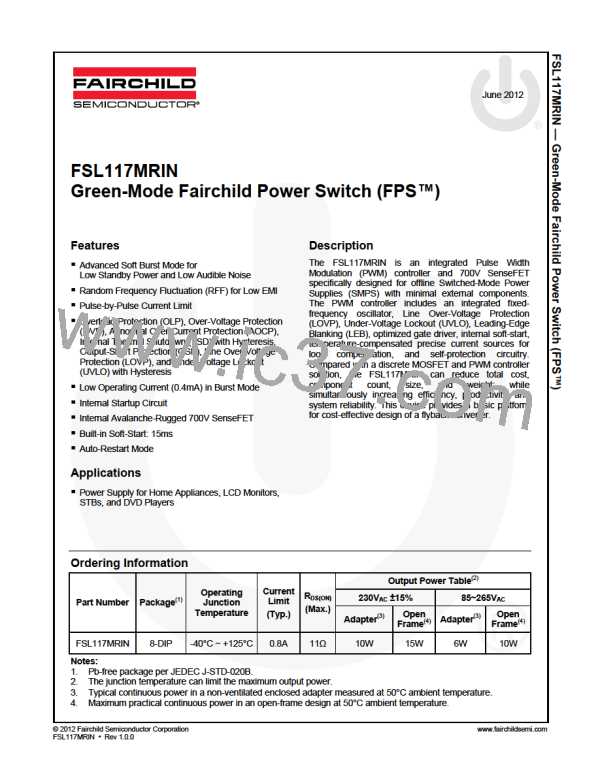4. Protection Circuits: The FSL117MRIN has several
self-protective functions, such as Overload Protection
(OLP), Abnormal Over-Current Protection (AOCP),
Output-Short Protection (OSP), Over-Voltage Protection
(OVP), and Thermal Shutdown (TSD). All the
protections are implemented as auto-restart. Once a
fault condition is detected, switching is terminated and
the SenseFET remains off. This causes VCC to fall.
When VCC falls to the Under-Voltage Lockout (UVLO)
stop voltage of 7.5V, the protection is reset and the
startup circuit charges the VCC capacitor. When VCC
reaches the start voltage of 12.0V, the FSL117MRIN
resumes normal operation. If the fault condition is not
removed, the SenseFET remains off and VCC drops to
stop voltage again. In this manner, the auto-restart can
alternately enable and disable the switching of the
power SenseFET until the fault condition is eliminated.
Because these protection circuits are fully integrated
into the IC without external components, the reliability is
improved without increasing cost.
blocked and the 2.0µA current source starts to charge
CFB slowly up. In this condition, VFB continues
increasing until it reaches 7.0V, when the switching
operation is terminated, as shown in Figure 21. The
delay for shutdown is the time required to charge CFB
from 2.5V to 7.0V with 2.0µA. A 25 ~ 50ms delay is
typical for most applications. This protection is
implemented as Auto-Restart Mode.
Figure 21. Overload Protection
4.2 Abnormal Over-Current Protection (AOCP):
When the secondary rectifier diodes or the
transformer pins are shorted, a steep current with
extremely high di/dt can flow through the SenseFET
during the minimum turn-on time. Overload protection
is not enough to protect the FSL117MRIN in that
abnormal case; since severe current stress is
imposed on the SenseFET until OLP is triggered. The
internal AOCP circuit is shown in Figure 22. When the
gate turn-on signal is applied to the power SenseFET,
the AOCP block is enabled and monitors the current
through the sensing-resistor. The voltage across the
resistor is compared with a preset AOCP level. If the
sensing resistor voltage is greater than the AOCP
level, the set signal is applied to the S-R latch,
resulting in the shutdown of the SMPS.
Figure 20. Auto-Restart Protection Waveforms
4.1 Overload Protection (OLP): Overload is defined
as the load current exceeding its normal level due to
an unexpected abnormal event. In this situation, the
protection circuit should trigger to protect the SMPS.
However, even when the SMPS is in normal
operation, the overload protection circuit can be
triggered during load transition. To avoid this
undesired operation, the overload protection circuit is
designed to trigger only after a specified time to
determine whether it is a transient situation or a true
overload situation. Because of the pulse-by-pulse
current-limit capability, the maximum peak current
through the SenseFET is limited and, therefore, the
maximum input power is restricted with a given input
voltage. If the output consumes more than this
maximum power, the output voltage (VOUT) decreases
below the set voltage. This reduces the current
through the opto-coupler LED, which also reduces the
opto-coupler transistor current, thus increasing the
feedback voltage (VFB). If VFB exceeds 2.5V, D1 is
Figure 22. Abnormal Over-Current Protection
© 2012 Fairchild Semiconductor Corporation
FSL117MRN • Rev.1.0.0
www.fairchildsemi.com
11

 FAIRCHILD [ FAIRCHILD SEMICONDUCTOR ]
FAIRCHILD [ FAIRCHILD SEMICONDUCTOR ]